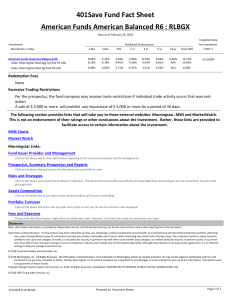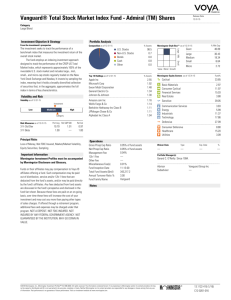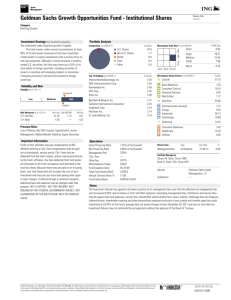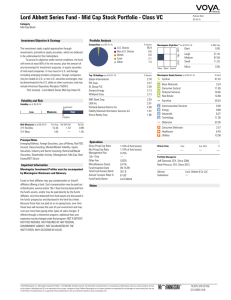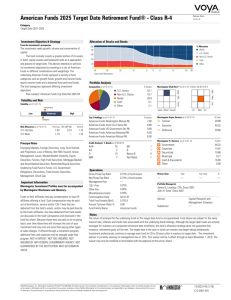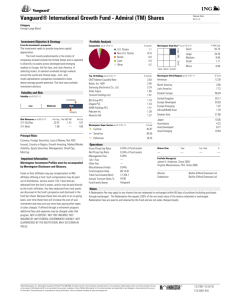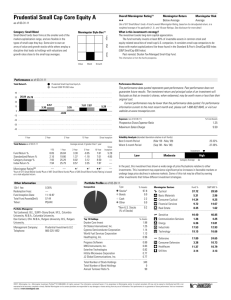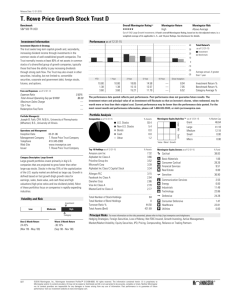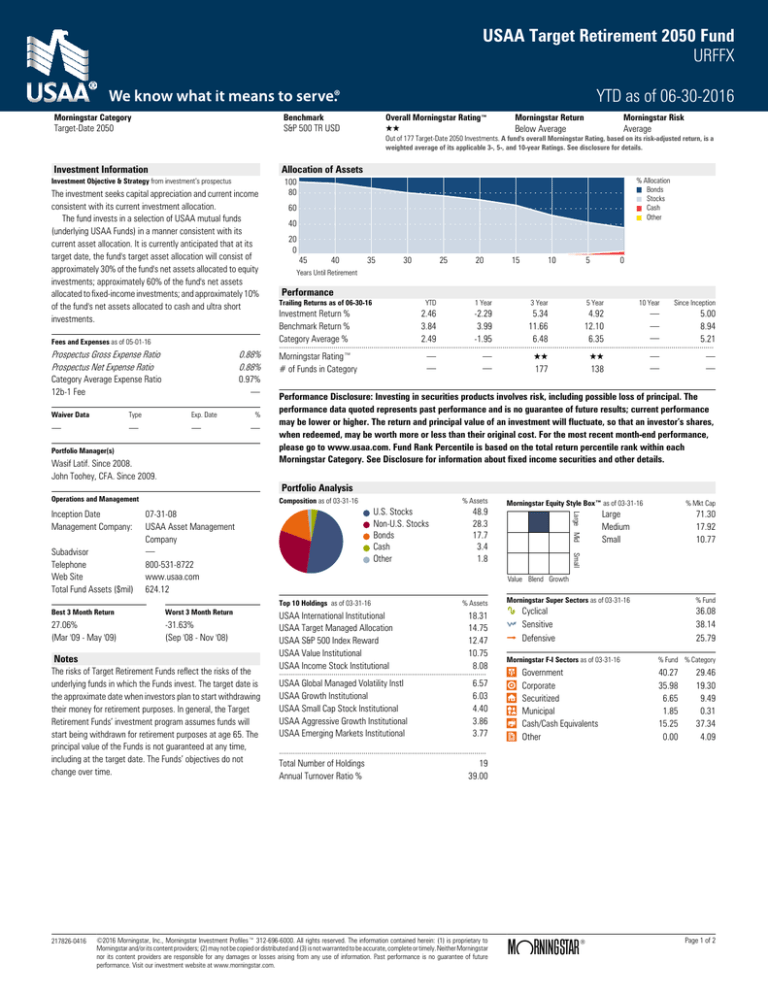
USAA Target Retirement 2050 Fund
URFFX
YTD as of 06-30-2016
Morningstar Category
Benchmark
Target-Date 2050
Overall Morningstar Rating™
S&P 500 TR USD
QQ
Morningstar Return
Morningstar Risk
Below Average
Average
Out of 177 Target-Date 2050 Investments. A fund's overall Morningstar Rating, based on its risk-adjusted return, is a
weighted average of its applicable 3-, 5-, and 10-year Ratings. See disclosure for details.
Allocation of Assets
Investment Information
Investment Objective & Strategy from investment’s prospectus
The investment seeks capital appreciation and current income
consistent with its current investment allocation.
The fund invests in a selection of USAA mutual funds
(underlying USAA Funds) in a manner consistent with its
current asset allocation. It is currently anticipated that at its
target date, the fund's target asset allocation will consist of
approximately 30% of the fund's net assets allocated to equity
investments; approximately 60% of the fund's net assets
allocated to fixed-income investments; and approximately 10%
of the fund's net assets allocated to cash and ultra short
investments.
Fees and Expenses as of 05-01-16
Prospectus Gross Expense Ratio
Prospectus Net Expense Ratio
Category Average Expense Ratio
12b-1 Fee
0.88%
0.88%
0.97%
.
Waiver Data
Type
Exp. Date
.
.
.
%
.
Portfolio Manager(s)
Wasif Latif. Since 2008.
John Toohey, CFA. Since 2009.
40
20
0
45
40
35
30
20
15
10
5
0
Performance
Trailing Returns as of 06-30-16
Investment Return %
Benchmark Return %
Category Average %
YTD
1 Year
3 Year
5 Year
10 Year
Since Inception
2.46
3.84
2.49
-2.29
3.99
-1.95
5.34
11.66
6.48
4.92
12.10
6.35
.
.
.
5.00
8.94
5.21
.
.
.
.
QQ
177
QQ
138
.
.
.
.
........................................................................................................................................................................................................................
Morningstar Rating™
# of Funds in Category
Performance Disclosure: Investing in securities products involves risk, including possible loss of principal. The
performance data quoted represents past performance and is no guarantee of future results; current performance
may be lower or higher. The return and principal value of an investment will fluctuate, so that an investor’s shares,
when redeemed, may be worth more or less than their original cost. For the most recent month-end performance,
please go to www.usaa.com. Fund Rank Percentile is based on the total return percentile rank within each
Morningstar Category. See Disclosure for information about fixed income securities and other details.
Composition as of 03-31-16
% Assets
27.06%
(Mar '09 - May '09)
-31.63%
(Sep '08 - Nov '08)
Notes
The risks of Target Retirement Funds reflect the risks of the
underlying funds in which the Funds invest. The target date is
the approximate date when investors plan to start withdrawing
their money for retirement purposes. In general, the Target
Retirement Funds’ investment program assumes funds will
start being withdrawn for retirement purposes at age 65. The
principal value of the Funds is not guaranteed at any time,
including at the target date. The Funds’ objectives do not
change over time.
Morningstar Equity Style Box™ as of 03-31-16
% Mkt Cap
Large
Medium
Small
71.30
17.92
10.77
Morningstar Super Sectors as of 03-31-16
% Fund
h Cyclical
j Sensitive
k Defensive
36.08
38.14
25.79
Value Blend Growth
Top 10 Holdings as of 03-31-16
Worst 3 Month Return
48.9
28.3
17.7
3.4
1.8
Small
U.S. Stocks
Non-U.S. Stocks
Bonds
Cash
Other
07-31-08
USAA Asset Management
Company
.
800-531-8722
www.usaa.com
624.12
Best 3 Month Return
217826-0416
25
Years Until Retirement
Large Mid
Subadvisor
Telephone
Web Site
Total Fund Assets ($mil)
60
Portfolio Analysis
Operations and Management
Inception Date
Management Company:
% Allocation
Bonds
Stocks
Cash
Other
100
80
USAA International Institutional
USAA Target Managed Allocation
USAA S&P 500 Index Reward
USAA Value Institutional
USAA Income Stock Institutional
% Assets
18.31
14.75
12.47
10.75
8.08
.......................................................................................................
USAA Global Managed Volatility Instl
USAA Growth Institutional
USAA Small Cap Stock Institutional
USAA Aggressive Growth Institutional
USAA Emerging Markets Institutional
6.57
6.03
4.40
3.86
3.77
Morningstar F-I Sectors as of 03-31-16
% Fund % Category
⁄
›
€
‹
fi
±
40.27
35.98
6.65
1.85
15.25
0.00
Government
Corporate
Securitized
Municipal
Cash/Cash Equivalents
Other
29.46
19.30
9.49
0.31
37.34
4.09
.......................................................................................................
Total Number of Holdings
Annual Turnover Ratio %
19
39.00
©2016 Morningstar, Inc., Morningstar Investment Profiles™ 312-696-6000. All rights reserved. The information contained herein: (1) is proprietary to
Morningstar and/or its content providers; (2) may not be copied or distributed and (3) is not warranted to be accurate, complete or timely. Neither Morningstar
nor its content providers are responsible for any damages or losses arising from any use of information. Past performance is no guarantee of future
performance. Visit our investment website at www.morningstar.com.
ß
®
Page 1 of 2
Disclosure
Performance
Total return reflects performance without adjusting for the
effects of taxation, but is adjusted to reflect all actual ongoing
fund expenses and assumes reinvestment of dividends and
capital gains.
The fund's performance is compared to an index. The index
is an unmanaged portfolio of specified securities and does not
reflect any initial or ongoing expenses. A fund's portfolio may
differ significantly from the securities in the index.
Morningstar provides adjusted historical returns and an
Extended Performance Rating for some mutual funds in its
universe. This means that any share class that doesn't have a
1, 3-, 5-, or 10-year performance history may receive a
hypothetical Morningstar Rating based on the oldest surviving
share class of the fund. First, Morningstar computes the funds'
new return stream by appending an adjusted return history of
the oldest share class. Next, the Extended Performance Rating
is determined by comparing the adjusted-historical returns to
the current open-end mutual fund universe to identify
placement in the bell curve used to assign the Morningstar
Rating.
The fixed income securities are subject to price volatility and a
number of risks, including interest rate risk. Interest rates and
bond prices move in opposite directions so that as interest rates
rise, bond prices usually fall, and vice versa. Interest rates are
currently at historically low levels. Fixed income securities also
carry other risks, such as inflation risk, liquidity risk, call risk,
and credit and default risks. Lower-quality fixed income
securities involve greater risk of default or price changes.
Securities of non-U.S. issuers generally involve greater risks
than U.S. investments, and can decline significantly in response
to adverse issuer, political, regulatory, market, and economic
risks. Fixed-income securities sold or redeemed prior to
maturity may be subject to loss.
Expenses
Expense ratio represents the total annual operating expenses,
as reported in the Fund's most current prospectus, and is
calculated as a percentage of average net assets (ANA).
Certain funds have management fees that can fluctuate
depending upon the fund's performance relative to a benchmark
index. For these funds, the management fees can be raised or
lowered by up to +/-0.06%. Any such performance adjustment
to the management fee will be applied monthly based upon the
36-month rolling performance of the fund versus the applicable
index. Please see the fund's prospectus for more information.
Best and Worst 3 Month Performance
Morningstar calculates best and worst 3-month period
(inpercentage) in-house on a monthly basis.
Best 3-month Period: The highest total return the stock has
posted in a consecutive three-month period over the trailing 15
years, or if a fund does not have 15 years of history, it will go
back as far as the inception date.
Worst 3-month Period: The lowest total return the stock has
posted in a consecutive three-month period over the trailing 15
years, or if a fund does not have 15 years of history, it will go
back as far as the inception date.
Growth of $10,000 Graph
This graph shows a fund's performance based on how $10,000
invested in the fund would have grown over time. The returns
used in the graph are not load-adjusted. The growth of $10,000
begins at the date of the fund's inception, or the first year listed
on the graph, whichever is appropriate. Located alongside the
fund's graph line is a line that represents the growth of $10,000
in an index. The inclusion of the index allows investors to
compare the performance of the fund with the performance of
a benchmark index.
217826-0416
Morningstar Rating™
Often simply called the Star Rating, the Morningstar Rating
brings load-adjustments, performance (returns) and risk
together into one evaluation. To determine a fund's star rating
for a given time period (three, five, or 10 years), the fund's riskadjusted return is plotted on a bell curve: If the fund scores in
the top 10% of its category, it receives 5 stars (Highest); if it
falls in the next 22.5% it receives 4 stars (Above Average); a
place in the middle 35% earns 3 stars (Average); those lower
still, in the next 22.5%, receive 2 stars (Below Average); and
the bottom 10% get only 1 star (Lowest). The Overall
Morningstar Rating is a weighted average of the available
three-, five-, and 10-year ratings.
Morningstar Return
This statistic is a measurement of a fund's excess return over
a risk-free rate (the return of the 90-day Treasury bill), after
adjusting for all applicable loads and sales charges. In each
Morningstar Category, the top 10% of funds earn a High
Morningstar Return, the next 22.5% Above Average, the middle
35% Average, the next 22.5% Below Average, and the bottom
10% Low. Morningstar Return is measured for up to three time
periods (three-, five-, and 10-years). These separate measures
are then weighted and averaged to produce an overall measure
for the fund. Funds with less than three years of performance
history are not rated.
Morningstar Risk
This statistic evaluates the variations in a fund's monthly
returns, with an emphasis on downside variations. In each
Morningstar Category, the 10% of funds with the lowest
measured risk are described as Low Risk, the next 22.5% Below
Average, the middle 35% Average, the next 22.5% Above
Average, and the top 10% High.
Morningstar Risk is measured for up to three time periods
(three-, five-, and 10-years). These separate measures are then
weighted and averaged to produce an overall measure for the
fund. Funds with less than three years of performance history
are not rated.
Fund Rank Percentile
This is the total return percentile rank within each Morningstar
Category. The highest (or most favorable) percentile rank is 1
and the lowest (or least favorable) percentile rank is 100.
Historical percentile ranks are based on a snapshot of the funds
as they were at the time of the calculation.
Percentile ranks within categories are most useful in those
groups that have a large number of funds. For small universes,
funds will be ranked at the highest percentage possible. For
instance, if there are only two specialty-utility funds with 10year average total returns, Morningstar will assign a percentile
rank of 1 to the top-performing fund, and the second fund will
earn a percentile rank of 51 (indicating the fund underperformed
50% of the sample).
Morningstar Style Box™
The Morningstar Style Box reveals a fund's investment style as
of the date noted on this report.
For equity funds the vertical axis shows the market
capitalization of the long stocks owned and the horizontal axis
shows investment style (value, blend, or growth).
For fixed-income funds, the vertical axis shows the credit
quality of the long bonds owned and the horizontal axis shows
interest rate sensitivity as measured by a bond's effective
duration.
Morningstar seeks credit rating information from fund
companies on a periodic basis (e.g., quarterly). In compiling
credit rating information Morningstar accepts credit ratings
reported by fund companies that have been issued by all
Nationally Recognized Statistical Rating Organizations
(NRSROs). For a list of all NRSROs, please visit http://
©2016 Morningstar, Inc., Morningstar Investment Profiles™ 312-696-6000. All rights reserved. The information contained herein: (1) is proprietary to
Morningstar and/or its content providers; (2) may not be copied or distributed and (3) is not warranted to be accurate, complete or timely. Neither Morningstar
nor its content providers are responsible for any damages or losses arising from any use of information. Past performance is no guarantee of future
performance. Visit our investment website at www.morningstar.com.
www.sec.gov/divisions/marketreg/ratingagency.htm.
Additionally, Morningstar accepts foreign credit ratings from
widely recognized or registered rating agencies. If two rating
organizations/agencies have rated a security, fund companies
are to report the lower rating; if three or more organizations/
agencies have rated a security, fund companies are to report
the median rating, and in cases where there are more than two
organization/agency ratings and a median rating does not exist,
fund companies are to use the lower of the two middle ratings.
PLEASE NOTE: Morningstar, Inc. is not itself an NRSRO nor does
it issue a credit rating on the fund. An NRSRO or rating agency
ratings can change from time-to-time and do not remove
market risk.
For credit quality, Morningstar combines the credit rating
information provided by the fund companies with an average
default rate calculation to come up with a weighted-average
credit quality. The weighted-average credit quality is currently
a letter that roughly corresponds to the scale used by a leading
NRSRO. Bond funds are assigned a style box placement of
"low", "medium", or "high" based on their average credit quality.
Funds with a low credit quality are those whose weightedaverage credit quality is determined to be less than "BBB-";
medium are those less than "AA-", but greater or equal to
"BBB-"; and high are those with a weighted-average credit
quality of "AA-" or higher. When classifying a bond portfolio,
Morningstar first maps the NRSRO credit ratings of the
underlying holdings to their respective default rates (as
determined by Morningstar's analysis of actual historical default
rates). Morningstar then averages these default rates to
determine the average default rate for the entire bond fund.
Finally, Morningstar maps this average default rate to its
corresponding credit rating along a convex curve.
For interest-rate sensitivity, Morningstar obtains from fund
companies the average effective duration. Generally,
Morningstar classifies a fixed-income fund's interest-rate
sensitivity based on the effective duration of the Morningstar
Core Bond Index (MCBI), which is currently three years. The
classification of Limited will be assigned to those funds whose
average effective duration is between 25% to 75% of MCBI's
average effective duration; funds whose average effective
duration is between 75% to 125% of the MCBI will be classified
as Moderate; and those that are at 125% or greater of the
average effective duration of the MCBI will be classified as
Extensive.
For municipal bond funds, Morningstar also obtains from
fund companies the average effective duration. In these cases
static breakpoints are utilized. These breakpoints are as follows:
(i) Limited: 4.5 years or less; (ii) Moderate: more than 4.5 years
but less than 7 years; and (iii) Extensive: more than 7 years. In
addition, for non-US taxable and non-US domiciled fixed income
funds static duration breakpoints are used: (i) Limited: less than
or equal to 3.5 years; (ii) Moderate: greater than 3.5 and less
than equal to 6 years; (iii) Extensive: greater than 6 years.
Additional Information
Consider the investment objectives, risks, charges and
expenses of the USAA mutual funds carefully before
investing. Contact us at 800-531-8910 for a prospectus
containing this and other information about the funds
from USAA Investment Management Company,
Distributor. Read it carefully before investing.
Investments provided by USAA Investment Management
Company and USAA Financial Advisors Inc., both registered
broker dealers, and affiliates
ß
®
Page 2 of 2

